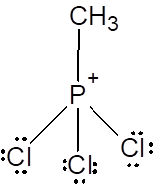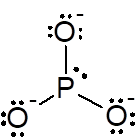
To find:
The molecular geometries of the given ions.
Answer to Problem 5.28QA
Solution:
The molecular geometries of the ions are (a) linear, (b) tetrahedral, (c) linear, and (d) trigonal pyramidal.
Explanation of Solution
a) SCN-:
i. The Lewis structure:
The total number of valence electrons in a molecule of SCN- is 16.
| Element | Valence electrons | ||
| Symbol | In one atom | Total | |
| S | 1 | 6 | 1 x 6 = 6 |
| C | 1 | 4 | 1 x 4 = 4 |
| N | 1 | 5 | 1 x 5 = 5 |
| Negative charge | 1 | ||
| Valence electrons in SCN- | 16 | ||
C is the central atom because C is least electronegative atom. The Lewis structure of SCN- is drawn by completing the octet of each element present in the molecule by adding lone pairs on it.

Formula to calculate steric number SN
ii. In the Lewis structure there is one S and one N atom attached to central C atom having no lone pair of electrons. So SN = 2. There is a -1 formal charge on S atom
iii. For SN = 2 and as the bond angle is 180o, molecular geometry is linear.
b) CH3PCl3+:
i. The Lewis structure:
The total number of valence electrons in a molecule of CH3PCl3+ is 32.
| Element | Valence electrons | ||
| Symbol | Number of atoms | In one atom | Total |
| C | 1 | 4 | 1 x 4 = 4 |
| H | 3 | 1 | 3 x 1 = 3 |
| P | 1 | 5 | 1 x 5 = 5 |
| Cl | 3 | 7 | 3 x 7 = 21 |
| Positive charge | -1 | ||
| Valence electrons in CH3PCl3+ | 32 | ||
P is the central atom. The Lewis structure of CH3PCl3+ is drawn by completing the octet of each element present in the molecule by adding lone pairs on it.

ii. In the Lewis structure there are three chlorine atoms and one CH3 group via C atom bonded to central P atom. So SN = 4. There is +1 formal charge on three O atoms. So SN = 4.
iii. For SN = 4, the molecular geometry is tetrahedral and bond angle is 109.5o.
c) ICl2-:
i. The Lewis structure:
The total number of valence electrons in a molecule of ICl2- is 22.
| Element | Valence electrons | ||
| Symbol | Number of atoms | In one atom | Total |
| I | 1 | 7 | 1 x 7 = 7 |
| Cl | 2 | 7 | 2 x 7 = 14 |
| Negative charge | 1 | ||
| Valence electrons in ICl2- | 22 | ||
I is the central atom because I is least electronegative atom. The Lewis structure of ICl2- is drawn by completing the octet of each element present in the molecule by adding lone pairs on it.

ii. In the Lewis structure there are two oxygen atoms bonded to central I atom. There are three lone pair on I atom with -1 formal charge. So SN = 5.
iii. For SN = 5, the electron geometry is trigonal bipyramidal. As all lone pairs are at equatorial position to minimize the repulsion the molecular geometry is linear.
d) PO33-:
i. The Lewis structure:
The total number of valence electrons in a molecule of PO33- is 26.
| Element | Valence electrons | ||
| Symbol | Number of atoms | In one atom | Total |
| P | 1 | 5 | 1 x 5 = 5 |
| O | 3 | 6 | 3 x 6 = 18 |
| Negative charge | 3 | ||
| Valence electrons in PO33- | 26 | ||
P is the central atom because P is least electronegative atom. The Lewis structure of PO33- is drawn by completing the octet of each element present in the molecule by adding lone pairs on it.

ii. In the Lewis structure there are three O atoms bonded to central P atom. There is one lone pair on P atom. So SN = 4.
iii. If SN = 4, the electron geometry is tetrahedral but as there is one lone pair on P atom and it is bonded to three O atoms the geometry is trigonal pyramidal.
Conclusion:
The molecular geometries of the ions are (a) linear, (b) tetrahedral, (c) linear, and (d) trigonal pyramidal.
Want to see more full solutions like this?
Chapter 5 Solutions
CHEM:ATOM FOC 2E CL (TEXT)
- Predict the product of this organic reaction: + NH2 HO A P+ H2O Specifically, in the drawing area below draw the skeletal ("line") structure of P. If there is no reasonable possibility for P, check the No answer box under the drawing area. Click and drag to start drawing a structure. ✓arrow_forward个 Stuc X ctclix ALE X A ALE × A ALE X Lab x (195 × Nut x M Inbx EF 目 → C www-awu.aleks.com/alekscgi/x/Isl.exe/10_u-IgNslkr7j8P3jH-IQ1g8NUi-mObKa_ZLx2twjEhK7mVG6PulJI006NcKTV37JxMpz Chapter 12 HW = Question 27 of 39 (5 points) | Question Attempt: 1 of Unlimited Part: 1/2 Part 2 of 2 Give the IUPAC name. Check 3 50°F Clear ©2025 McGraw Hill L Q Search webp a عالياكarrow_forward个 Stuck x ctc xALE X A ALE × A ALE X Lab x (19: x - G www-awu.aleks.com/alekscgi/x/Isl.exe/10_u-lgNslkr7j8P3jH-1Q1g8NUi-mObka ZLx2twjEhK7mVG6PUUIO06 Chapter 12 HW 三 Question 26 of 39 (4 points) 1 Question Attempt: 1 of Unlimited Answer the following questions about the given alkane. Part: 0 / 2 Part 1 of 2 Give the IUPAC name. Skip Part 2 53°F Clear Check × Q Search hp hp 02arrow_forward
- Calculate the equilibrium constant at 25.0 oC for the following equation. Cd(s) + Sn+2(aq) ↔Cd+2(aq) + Sn(s) Group of answer choices 3.11x104 1.95x1018 9.66x108 1.40x109arrow_forwardWhat is the pH at the cathode for the following cell written in line notation at 25.0 oC with a Ecell = -0.2749 V? Ni(s)|Ni+2(aq, 1.00 M)||H+1(aq, ?M)|H2(g, 1.00 atm)|Pt(s)arrow_forwardCalculate Ecell for a hydrogen fuel cell at 95.0 oC using the following half-reactions with PH2 = 25.0 atm and PO2 = 25.0 atm. O2(g) + 4H+1(aq) + 4e-1 → 2H2O(l) Eo = 1.229 V 2H2(g) → 4H+1(aq) + 4e-1 Eo = 0.00 Varrow_forward
- Calculate Ecell at 25.0 oC using the following half-reactions with [Ag+1] = 0.0100 M and [Sn+2] = 0.0200 M. Ag+1(aq) + 1e-1 Ag(s) Sn+2(aq) + 2e-1 Sn(s)arrow_forwardDone 18:19 www-awu.aleks.com Chapter 12 HW Question 27 of 39 (5 points) | Question Attempt: 1 of Unlimited .. LTE סוי 9 ✓ 20 ✓ 21 × 22 23 24 25 26 27 28 29 30 Answer the following questions about the given alkane. Part: 0 / 2 Part 1 of 2 Classify each carbon atom as a 1º, 2º, 3º, or 4°. Highlight in red any 1° carbons, highlight in blue any 2° carbons. highlight in green any 3° carbons, and leave any 4° carbons unhighlighted. Skip Part Check Save For Later © 2025 McGraw Hill LLC. All Rights Reserved. Terms of Use Privacy Center | Accessibility ☑ คarrow_forward< Done 19:22 www-awu.aleks.com Chapter 12 HW Question 4 of 39 (2 points) | Question Attempt: 5 of Unlimited : .. LTE סוי 1 ✓ 2 ✓ 3 = 4 ✓ 5 ✓ 6 ✓ 7 ✓ 8 ✓ 9 = 10 11 ✓ 12 Consider the molecule (CH3)2CHCH2CHCн for the following questions. Part 1 of 2 Which of the following molecules is/are constitutional isomer(s) to (CH3)2CHCH2CH2CH3? Check all that apply. Part 2 of 2 (CH3),C(CH2)2CH3 CH3 H,C-CH-CH-CH, CH 3 None of the above. ☑ Which of the following molecules is/are identical molecules to (CH3)2CHCH2CH2CH₁₂? Check all that apply. CH3 H,C-CH-CH₂-CH2-CH, CH3(CH2)2CH(CH3)2 CH2-CH2-CH3 HỌC-CH=CH, 乂 ☑ а None of the above Check Save For Later Submit Assignment © 2025 McGraw Hill LLC. All Rights Reserved. Terms of Use | Privacy Center Accessibilityarrow_forward
- 18:11 LTE ا... US$50 off hotels is waiting for you Book now, hotels in Nashville are going fast QUTSLIVII 25 61 69 points) | QuestIVIT ALLēm... now Give the IUPAC name for each compound. Part 1 of 3 Part 2 of 3 X ☑ Х Check Save For Later Submit © 2025 McGraw Hill LLC. All Rights Reserved. TOMS CT US ...vacy Center | Accessibilityarrow_forwardDone 19:17 www-awu.aleks.com Chapter 12 HW Question 29 of 39 (6 points) | Question Attempt: 1 of Unlimited .III LTE סוי 27 28 = 29 30 31 32 = 33 34 35 Consider this structure. CH3CH2CH2 Part 1 of 3 3 CH2 CH2CH3 - C-CH2CH 3 H CH₂ Give the IUPAC name of this structure. 3-ethyl-3,4-dimethylheptane Part: 1/3 Part 2 of 3 Draw the skeletal structure. Skip Part < Check Click and drag to start drawing a structure. Save For Later Submit © 2025 McGraw Hill LLC. All Rights Reserved. Terms of Use | Privacy Center | Accessibility Хarrow_forward18:57 .III LTE www-awu.aleks.com Chapter 12 HW Question 31 of 39 (8 points) | Question Attem... Give the IUPAC name of each compound. Part 1 of 4 Part 2 of 4 Х Х Check Save For Later Submit © 2025 McGraw Hill LLC. All Rights Reserved. TOMS OF US vacy Center | Accessibilityarrow_forward
 ChemistryChemistryISBN:9781305957404Author:Steven S. Zumdahl, Susan A. Zumdahl, Donald J. DeCostePublisher:Cengage Learning
ChemistryChemistryISBN:9781305957404Author:Steven S. Zumdahl, Susan A. Zumdahl, Donald J. DeCostePublisher:Cengage Learning ChemistryChemistryISBN:9781259911156Author:Raymond Chang Dr., Jason Overby ProfessorPublisher:McGraw-Hill Education
ChemistryChemistryISBN:9781259911156Author:Raymond Chang Dr., Jason Overby ProfessorPublisher:McGraw-Hill Education Principles of Instrumental AnalysisChemistryISBN:9781305577213Author:Douglas A. Skoog, F. James Holler, Stanley R. CrouchPublisher:Cengage Learning
Principles of Instrumental AnalysisChemistryISBN:9781305577213Author:Douglas A. Skoog, F. James Holler, Stanley R. CrouchPublisher:Cengage Learning Organic ChemistryChemistryISBN:9780078021558Author:Janice Gorzynski Smith Dr.Publisher:McGraw-Hill Education
Organic ChemistryChemistryISBN:9780078021558Author:Janice Gorzynski Smith Dr.Publisher:McGraw-Hill Education Chemistry: Principles and ReactionsChemistryISBN:9781305079373Author:William L. Masterton, Cecile N. HurleyPublisher:Cengage Learning
Chemistry: Principles and ReactionsChemistryISBN:9781305079373Author:William L. Masterton, Cecile N. HurleyPublisher:Cengage Learning Elementary Principles of Chemical Processes, Bind...ChemistryISBN:9781118431221Author:Richard M. Felder, Ronald W. Rousseau, Lisa G. BullardPublisher:WILEY
Elementary Principles of Chemical Processes, Bind...ChemistryISBN:9781118431221Author:Richard M. Felder, Ronald W. Rousseau, Lisa G. BullardPublisher:WILEY





